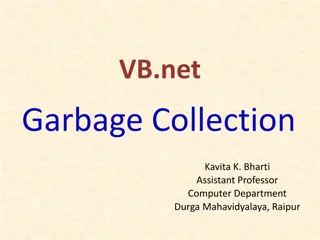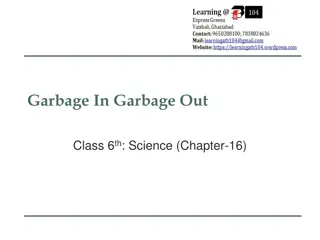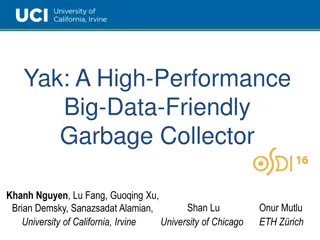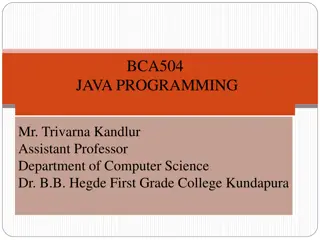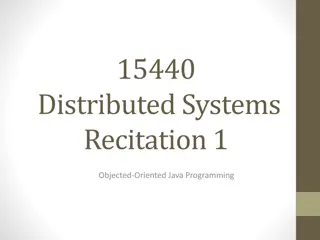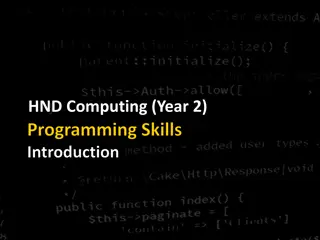Understanding Garbage Collection in Java Programming
Garbage collection in Java automates the process of managing memory allocation and deallocation, ensuring efficient memory usage and preventing memory leaks and out-of-memory errors. By automatically identifying and removing unused objects from the heap memory, the garbage collector frees up memory space, allowing Java programs to run smoothly without requiring manual memory management by programmers.
Download Presentation

Please find below an Image/Link to download the presentation.
The content on the website is provided AS IS for your information and personal use only. It may not be sold, licensed, or shared on other websites without obtaining consent from the author. Download presentation by click this link. If you encounter any issues during the download, it is possible that the publisher has removed the file from their server.
E N D
Presentation Transcript
Amity School of Engineering & Technology Garbage Collection and Runtime Classes 1
Amity School of Engineering & Technology Garbage Collection Garbage collection in Java is the process by which Java programs perform management. Java programs compile to bytecode that can be run on a Java Virtual Machine, When Java programs run on the JVM, objects are created on the heap, which is a portion of memory dedicated to the program. Eventually, some objects will no longer be needed. The garbage collector finds these unused objects and deletes them to free up memory. automatic memory
Amity School of Engineering & Technology What is Garbage Collection? In C/C++, a programmer is responsible for both the creation and destruction of objects. Usually, programmer neglects the destruction of useless objects. Due to this negligence, at a certain point, sufficient memory may not be available to create new objects, and the entire program will terminate abnormally, causing OutOfMemoryErrors.
Amity School of Engineering & Technology Cont.. In java the programmer need not care for all those objects which are no longer in use. Garbage collector destroys these objects. The main objective of Garbage Collector is to free heap memory by destroying unreachable objects. The garbage collector is the best example of the Daemon thread as it is always running in the background.
Amity School of Engineering & Technology How Does Garbage Collection in Java works? Java garbage collection is an automatic process. Automatic garbage collection is the process of looking at heap memory, identifying which objects are in use and which are not, and deleting the unused objects. An in-use object, or a referenced object, means that some part of your program still maintains a pointer to that object. An unused or unreferenced object is no longer referenced by any part of your program. So the memory used by an unreferenced object can be reclaimed. The programmer does not need to mark objects to be deleted explicitly. The garbage collection implementation lives in the JVM.
Amity School of Engineering & Technology How can an object be unreferenced?
Amity School of Engineering & Technology By nulling a reference Employee e=new Employee(); e=null;
Amity School of Engineering & Technology By assigning a reference to another Employee e1=new Employee(); Employee e2=new Employee(); e1=e2;//now the first object referred by e1 i s available for garbage collection
Amity School of Engineering & Technology By anonymous object new Employee();
Amity School of Engineering & Technology finalize() method The finalize() method is invoked each time before the object is garbage collected. This method can be used to perform cleanup processing. This method is defined in Object class as: protected void finalize(){}
Amity School of Engineering & Technology gc() method The gc() method is used to invoke the garbage collector to perform cleanup processing. The gc() is found in System and Runtime classes. public static void gc(){}
Amity School of Engineering & Technology Example public class expgar{ public void finalize(){ System.out.println("object is garbage collected");} public static void main(String args[]){ expgar s1=new expgar(); expgar s2=new expgar(); s1=null; s2=null; System.gc(); } }
Amity School of Engineering & Technology Java Runtime classes Java Runtime classes is used to interact with java runtime environment. Java Runtime class provides methods to execute a process, invoke GC, get total and free memory etc. There is only one instance of java.lang.Runtime class is available for one java application.
Amity School of Engineering & Technology Methods of Java Runtime class No. Method Description 1) public getRuntime() static Runtime returns Runtime class. the instance of 2) public void exit(int status) terminates the current virtual machine. 3) public addShutdownHook(Thread hook) void registers new hook thread. 4) public command)throws IOException Process exec(String executes given command in a separate process. 5) public availableProcessors() int returns processors. no. of available 6) public long freeMemory() returns memory in JVM. amount of free 7) public long totalMemory() returns memory in JVM. amount of total
Amity School of Engineering & Technology Java Runtime exec() method public class Runtime1{ public static void main(String args[])throws Ex ception{ Runtime.getRuntime().exec("notepad"); //will open a new notepad } }
Amity School of Engineering & Technology How to shutdown system in Java You can use shutdown -s command to shutdown system. For windows OS, you need to provide full path of shutdown command e.g. c:\\Windows\\System32\\shutdown. Here you can use -s switch to shutdown system, -r switch to restart system and -t switch to specify time delay.
Amity School of Engineering & Technology Example public class Runtime2{ public static void main(String args[])throws Exception{ Runtime.getRuntime().exec("shutdown -s -t 0"); } }
Amity School of Engineering & Technology How to shutdown windows system in Java public class Runtime2{ public static void main(String args[])throws Exception{ Runtime.getRuntime().exec("c:\\Windows\\Syste m32\\shutdown -s -t 0"); } }
Amity School of Engineering & Technology How to restart system in Java public class Runtime3{ public static void main(String args[])throw s Exception{ Runtime.getRuntime().exec("shutdown -r - t 0"); } }
Amity School of Engineering & Technology Java Runtime availableProcessors() public class Runtime4{ public static void main(String args[])throw s Exception{ System.out.println(Runtime.getRuntime().a vailableProcessors()); } }
Amity School of Engineering & Technology Java Runtime freeMemory() and totalMemory() method public class MemoryTest{ public static void main(String args[])throws E xception{ Runtime r=Runtime.getRuntime(); System.out.println("Total Memory: "+r.totalMe mory()); System.out.println("Free Memory: "+r.freeMem ory());
Amity School of Engineering & Technology for(int i=0;i<10000;i++){ new MemoryTest(); } System.out.println("After creating 10000 instance, Free Memory: "+r.freeMemory()); System.gc(); System.out.println("After gc(), Free Memory: "+r.fr eeMemory()); } }






